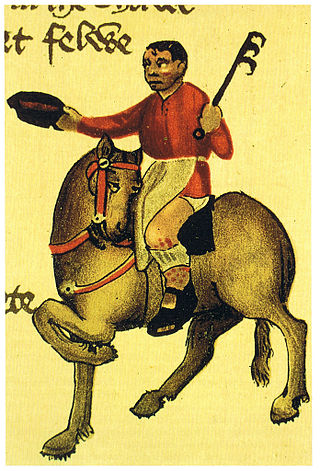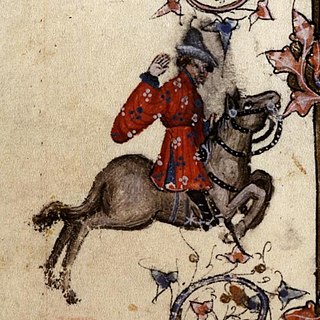
The Canterbury Tales is a collection of twenty-four stories that runs to over 17,000 lines written in Middle English by Geoffrey Chaucer between 1387 and 1400. It is widely regarded as Chaucer's magnum opus. The tales are presented as part of a story-telling contest by a group of pilgrims as they travel together from London to Canterbury to visit the shrine of Saint Thomas Becket at Canterbury Cathedral. The prize for this contest is a free meal at the Tabard Inn at Southwark on their return.

This article contains summaries and commentaries of the 100 stories within Giovanni Boccaccio's The Decameron.

"The Miller's Tale" is the second of Geoffrey Chaucer's Canterbury Tales (1380s–1390s), told by the drunken miller Robin to "quite" "The Knight's Tale". The Miller's Prologue is the first "quite" that occurs in the tales.

"The Wife of Bath's Tale" is among the best-known of Geoffrey Chaucer's Canterbury Tales. It provides insight into the role of women in the Late Middle Ages and was probably of interest to Chaucer himself, for the character is one of his most developed ones, with her Prologue twice as long as her Tale. He also goes so far as to describe two sets of clothing for her in his General Prologue. She holds her own among the bickering pilgrims, and evidence in the manuscripts suggests that although she was first assigned a different, plainer tale—perhaps the one told by the Shipman—she received her present tale as her significance increased. She calls herself both Alyson and Alys in the prologue, but to confuse matters these are also the names of her 'gossib', whom she mentions several times, as well as many female characters throughout The Canterbury Tales.

"The Cook's Tale" is one of the Canterbury Tales by Geoffrey Chaucer. It breaks off after 58 lines and was presumably never finished, although some scholars argue that Chaucer deliberately left the tale unfinished. The story starts telling of an apprentice named Perkyn who is fond of drinking and dancing. Perkyn is released by his master and moves in with a friend who also loves to drink, and whose wife is a shopkeeper whose real occupation is that of a prostitute.

"The Merchant's Tale" is one of Geoffrey Chaucer's Canterbury Tales. In it Chaucer subtly mocks antifeminist literature like that of Theophrastus ("Theofraste"). The tale also shows the influence of Boccaccio, Deschamps' Le Miroir de Mariage, Roman de la Rose by Guillaume de Lorris, Andreas Capellanus, Statius, and Cato. The tale is found in Persia in the Bahar Danush, in which the husband climbs a date tree instead of a pear tree. It could have arrived in Europe through the One Thousand and One Nights, or perhaps the version in book VI of the Masnavi by Rumi. Though several of the tales are sexually explicit by modern standards, this one is especially so. Larry Benson remarks:
The central episode of the Merchant's Tale is like a fabliau, though of a very unusual sort: It is cast in the high style, and some of the scenes are among Chaucer's most elaborate displays of rhetorical art.
A fabliau is a comic, often anonymous tale written by jongleurs in northeast France between c. 1150 and 1400. They are generally characterized by sexual and scatological obscenity, and by a set of contrary attitudes—contrary to the church and to the nobility. Several of them were reworked by Giovanni Boccaccio for the Decameron and by Geoffrey Chaucer for his Canterbury Tales. Some 150 French fabliaux are extant, the number depending on how narrowly fabliau is defined. According to R. Howard Bloch, fabliaux are the first expression of literary realism in Europe.

"The Man of Law's Tale" is the fifth of the Canterbury Tales by Geoffrey Chaucer, written around 1387. John Gower's "Tale of Constance" in Confessio Amantis tells the same story and may have been a source for Chaucer. Nicholas Trivet's Les chronicles was a source for both authors.

"The Clerk's Tale" is the first tale of Group E in Geoffrey Chaucer's The Canterbury Tales. It is preceded by The Summoner's Tale and followed by The Merchant's Tale. The Clerk of Oxenford is a student of what would nowadays be considered philosophy or theology. He tells the tale of Griselda, a young woman whose husband tests her loyalty in a series of cruel torments that recall the biblical Book of Job.

"The Friar's Tale" is a story in The Canterbury Tales by Geoffrey Chaucer, told by Huberd the Friar. The story centers on a corrupt summoner and his interactions with the Devil. It is preceded by The Wife of Bath's Tale and followed by The Summoner's Tale.

"The Shipman's Tale" is one of The Canterbury Tales by Geoffrey Chaucer.

The Canterbury Tales is a 1972 Italian film directed by Pier Paolo Pasolini based on the medieval narrative poem by Geoffrey Chaucer. The second film in Pasolini's "Trilogy of Life", preceded by The Decameron and followed by Arabian Nights, it won the Golden Bear at the 22nd Berlin International Film Festival.

The loathly lady, is a tale type commonly used in medieval literature, most famously in Geoffrey Chaucer's The Wife of Bath's Tale. The motif is that of a woman who appears unattractive but undergoes a transformation upon being approached by a man in spite of her unattractiveness, becoming extremely desirable. It is then revealed that her ugliness was the result of a curse which was broken by the hero's action.

The Decameron is a 1971 anthology film written and directed by Pier Paolo Pasolini, based on the 14th-century allegory by Giovanni Boccaccio. It is the first film of Pasolini's Trilogy of Life, the others being The Canterbury Tales and Arabian Nights. Each film was an adaptation of a different piece of classical literature focusing on ribald and often irreligious themes. The tales contain abundant nudity, sex, slapstick and scatological humour.

Griselda is a figure in European folklore noted for her patience and obedience.
The bed trick is a plot device in traditional literature and folklore; it involves a substitution of one partner in the sex act with a third person. In the standard and most common form of the bed trick, a man goes to a sexual assignation with a certain woman, and without his knowledge that woman's place is taken by a substitute.

The Decameron, subtitled Prince Galehaut and sometimes nicknamed l'Umana commedia, is a collection of short stories by the 14th-century Italian author Giovanni Boccaccio (1313–1375). The book is structured as a frame story containing 100 tales told by a group of seven young women and three young men; they shelter in a secluded villa just outside Florence in order to escape the Black Death, which was afflicting the city. Boccaccio probably conceived of the Decameron after the epidemic of 1348, and completed it by 1353. The various tales of love in The Decameron range from the erotic to the tragic. Tales of wit, practical jokes, and life lessons contribute to the mosaic. In addition to its literary value and widespread influence, it provides a document of life at the time. Written in the vernacular of the Florentine language, it is considered a masterpiece of early Italian prose.

Decameron Nights is a 1953 anthology Technicolor film based on three tales from The Decameron by Giovanni Boccaccio, specifically the ninth and tenth tales of the second day and the ninth tale of the third. It stars Joan Fontaine and, as Boccaccio, Louis Jourdan.
The Prologue and Tale of Beryn are spurious fifteenth century additions to Geoffrey Chaucer's Canterbury Tales. They are both written in Middle English.
In fabliaux, bacon is one of the most commonly consumed foodstuffs, alongside capons and geese, cakes, bread, and wine.

















